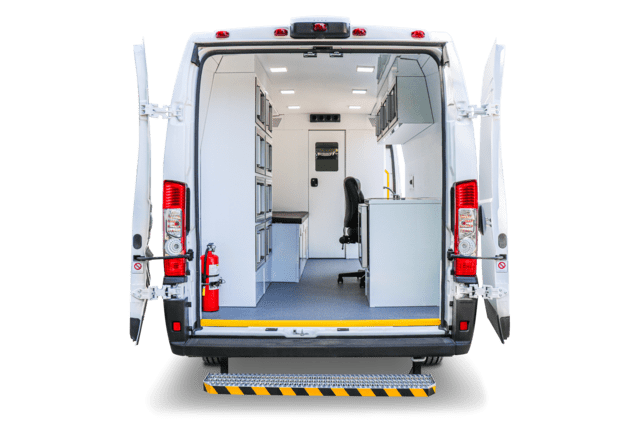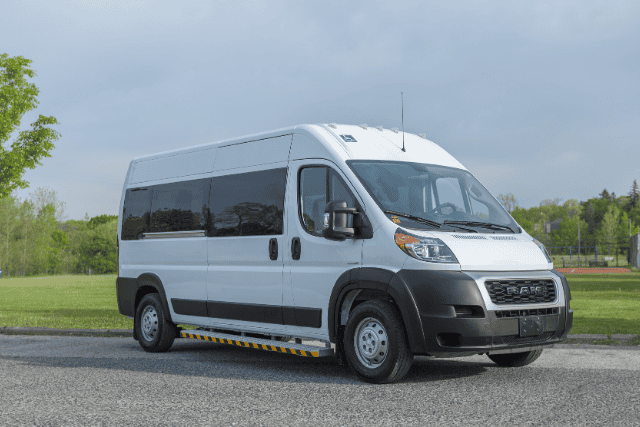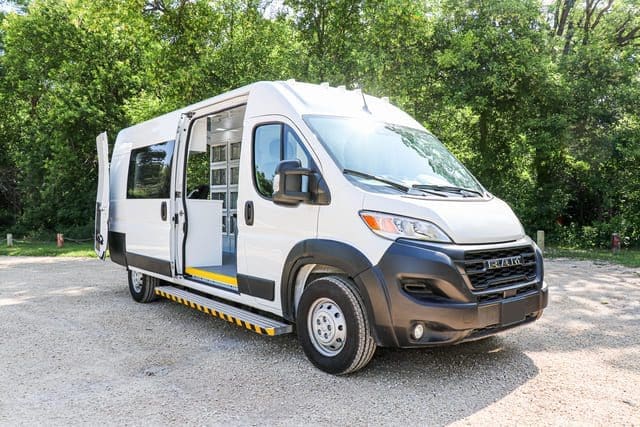Are you worried about making the wrong choice when investing in a mobile medical vehicle? Imagine being on your way to a community health event, fully booked with patients, when your unit suddenly breaks down. The event is canceled, care is delayed, and your reputation takes a hit.
You want a mobile medical unit that works seamlessly and helps you serve your community—not one that leaves you and your patients stranded on the side of the road. We understand how stressful this decision can be. You need a vehicle that’s reliable, easy to maintain, and worth the investment.
Here’s the problem: Many medical RVs out there aren’t built to handle the constant wear and tear of daily use. Choosing one could cost you time, money, and even your organization’s reputation. But there’s good news—you can avoid these problems with a solution that runs smoothly, keeps maintenance simple, and lets you focus on what matters most: helping people.
Why trust us? At AVAN Mobility, we have helped organizations that have decided on convenient vehicles with innovative solutions, such as CalOptima and the Community Clinic of Southwest Missouri. In this article, we’ll explore why medical RVs often fall short and what you should consider doing to avoid costly mistakes. Let’s make sure you get it right the first time.
What Is a Medical RV?
A medical RV is a recreational vehicle (RV) that’s been transformed into a mobile medical clinic. These vehicles are designed to bring healthcare directly to communities, especially in areas where access to medical services is limited. Think of it as a doctor’s office or clinic on wheels.
What makes a medical RV different from a regular RV?
Unlike traditional RVs built for camping or travel, medical RVs are customized with medical equipment and facilities. Here’s what you’ll often find inside:
- Exam rooms: Spaces for doctors or nurses to treat patients.
- Specialized equipment: Like X-ray machines, dental chairs, or lab tools.
- Waiting areas: A small space for patients to sit before their appointment.
- Storage: Cabinets and shelves for medical supplies.
Who uses medical RVs?
Medical RVs are commonly used by:
- Hospitals and clinics extending their services.
- Nonprofits offering free or low-cost care.
- Governments during emergencies or disasters.
Are medical RVs tough to maintain?
Medical RVs can be lifesaving tools for many people across the U.S., but they come with unique challenges. Below, we’ll break down five key reasons why these vehicles can be unreliable and hard to maintain, highlighting how each issue impacts your operations.
1. Medical RVs face heavy daily use
As we mentioned, a medical RV is a clinic on wheels, and unlike recreational RVs, which may only be used seasonally, medical RVs often run daily, traveling long distances and serving many patients throughout the day.
How can this cause problems?
Increased strain: The extra weight of medical equipment puts stress on the engine, suspension, and tires.
More wear and tear: Daily use means parts like brakes and belts wear out faster.
Frequent maintenance needs: Routine upkeep is required more often, leading to higher costs and downtime. When your RV is out of commission and getting repaired, your RV medic team area also without work, and people are missing out on healthcare.
Without a vehicle built to handle this level of usage, breakdowns can become an expensive and constant headache.
2. Mobile RV medics are scarce in remote locations
One of the main advantages of a medical RV is its ability to reach underserved areas. However, staffing a medical RV in remote locations brings a unique set of challenges.
Here’s why this matters:
Tough to find staff: Mobile RV medics who specialize in specific RV medical systems are rare, especially in rural areas.
Dependency on travel: Often, RV medics must travel long distances to reach the mobile unit, resulting in extended wait times and potential disruptions to patient care schedules.
3. Lack of standardization across medical RV designs
Another reason why medical RVs are so unreliable is the lack of industry-wide standards for their design and construction. Unlike traditional RVs, which follow more uniform specifications, medical RVs are often custom-built.
How this leads to problems:
Inconsistent quality: Each manufacturer may use different materials, layouts, or systems, making it hard to predict reliability.
Repair challenges: Technicians unfamiliar with your specific RV build may struggle to diagnose or fix issues.
Compatibility issues: Parts or systems in one medical RV might not be compatible with those from another, limiting repair options.
Without standardization, maintaining and repairing a medical RV can feel like navigating a maze, increasing costs and downtime for organizations.
4. Technicians can struggle with complex repairs
Even when you think you’ve found a good mobile RV medic vehicle, the complexity of RVs often makes repairs more difficult. These vehicles combine the mechanics of a regular RV with advanced medical technology.
Common repair challenges include:
Integrated systems: Medical RVs often have custom-built features that require specialized knowledge.
Limited parts availability: Medical-grade equipment parts aren’t typically stocked by standard repair providers. Parts for medical equipment or custom features often need to be ordered, causing delays. Without quick repair options, you may face extended downtime, impacting patient care. This lack of support can create significant barriers to delivering consistent healthcare services.
Miscommunication: General RV repair professionals may not fully understand the specific needs of your medical equipment.
Limited local expertise: Local mechanics or technicians may lack the training needed to repair advanced medical systems or custom vehicle modifications, requiring specialized support that may not be readily available.
5. Poor manufacturing leads to long-term issues
Not all medical RVs are created equal. Some manufacturers cut corners by using cheap materials or modifying standard RVs that aren’t designed to handle the weight and wear of a medical clinic.
What happens with poorly built medical RVs:
Wear and tear on suspension parts: As mentioned earlier, frames and suspensions may fail under the weight of medical equipment.
Premature breakdowns: Essential systems like generators or HVAC units often break down prematurely. When an HVAC unit breaks down, it can leave your healthcare team and patients feeling uncomfortable in the scorching heat.
Ongoing issues: You may face recurring issues that drive up repair costs and reduce reliability. Cheaper parts often break down much quicker than OEM parts.
Choosing the wrong manufacturer can turn your investment into a liability instead of a lifesaving tool.
What’s the solution to unreliable medical RVs?
If these challenges of medical RVs seem overwhelming to you, why not consider another option? Mobile medical vans are another option that is built to handle the daily demands of healthcare services without the hefty price tag or constant maintenance headaches that come with medical RVs.
Why might mobile medical vans be a better option?
Mobile medical vans are designed specifically for healthcare on the move. Unlike RVs, which are modified recreational vehicles, vans are purpose-built for efficiency and durability.
Key advantages of mobile medical vans:
- Longer lifespan: When properly cared for with routine maintenance, a mobile medical van can last up to 20 years.
- Lower upfront cost: Vans are significantly cheaper to purchase than medical RVs.
- Fewer maintenance issues: Mobile vans don’t have as many moving parts as medical RVs, minimizing breakdowns and repair needs.
How much can you save with a mobile medical van?
One of the biggest drawbacks of medical RVs is the cost of ownership. With RVs, you can expect:
Regular expenses: These are typically double compared to mobile vans.
Maintenance costs: Repairs can easily be three times higher than those for a van.
With mobile medical vans, these costs are far lower, making them a smarter financial choice for organizations that need reliable, long-term solutions.
Medical RVs vs. medical van: which will you choose?

You came here because you wanted to know why medical RVs can be so unreliable and hard to keep running. Things like constant repairs, high costs, and limited repair options can make owning one a real struggle—but now you know there’s a better way.
If you’re looking for something dependable that helps you deliver care without all the stress, a mobile medical van could be the perfect solution.
At AVAN Mobility, our vans are reliable, high-quality, and designed to keep you focused on what matters most—helping your community and saving lives. We’d love to help you find the right vehicle for your needs. Click the button below to chat with a mobility expert who’s ready to help.
Not ready to talk just yet? No problem! Check out some of our other helpful resources to learn more.
Start with our article on the pros and cons of mobile medical vans and RV clinics. This will give you even more information to consider to help you make the right choice.
After that, check out our article on the maintenance differences between mobile medical vans and RVs.





